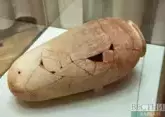Fragments of carved bone unearthed at an ancient site on a Turkish hillside are evidence that the people who spent time there belonged to a neolithic 'skull cult' – a group that embraces rituals around the heads of the dead.
The remains were uncovered during field work at Göbekli Tepe, an 11,000-year-old site in the south-east of the country, where thousands of pieces of human bone were found, including sections of skulls bearing grooves, holes and the occasional dab of ochre, the Guardian writes.
"In the Pre-Pottery Neolithic of Southeast Anatolia and the Levant, there is an abundance of archaeological evidence for the special status assigned to the human skull: In addition to the deposition of skulls in special places, human skulls are also known to have been decorated, for example, where the soft tissue and facial features have been remodeled in plaster," according to a report in Science Advances.
The scientists discovered the bits of skull in two trenches at the 300 metre-wide site on a hilltop about 30 miles (50km) north of the Syrian border. Excavations which began at the site in the mid-1990s uncovered eight large oval buildings there. At the centre of each stand two T-shaped pillars which resemble people rising to more than 5 metres high. Smaller pillars of the same design are built into the walls.










